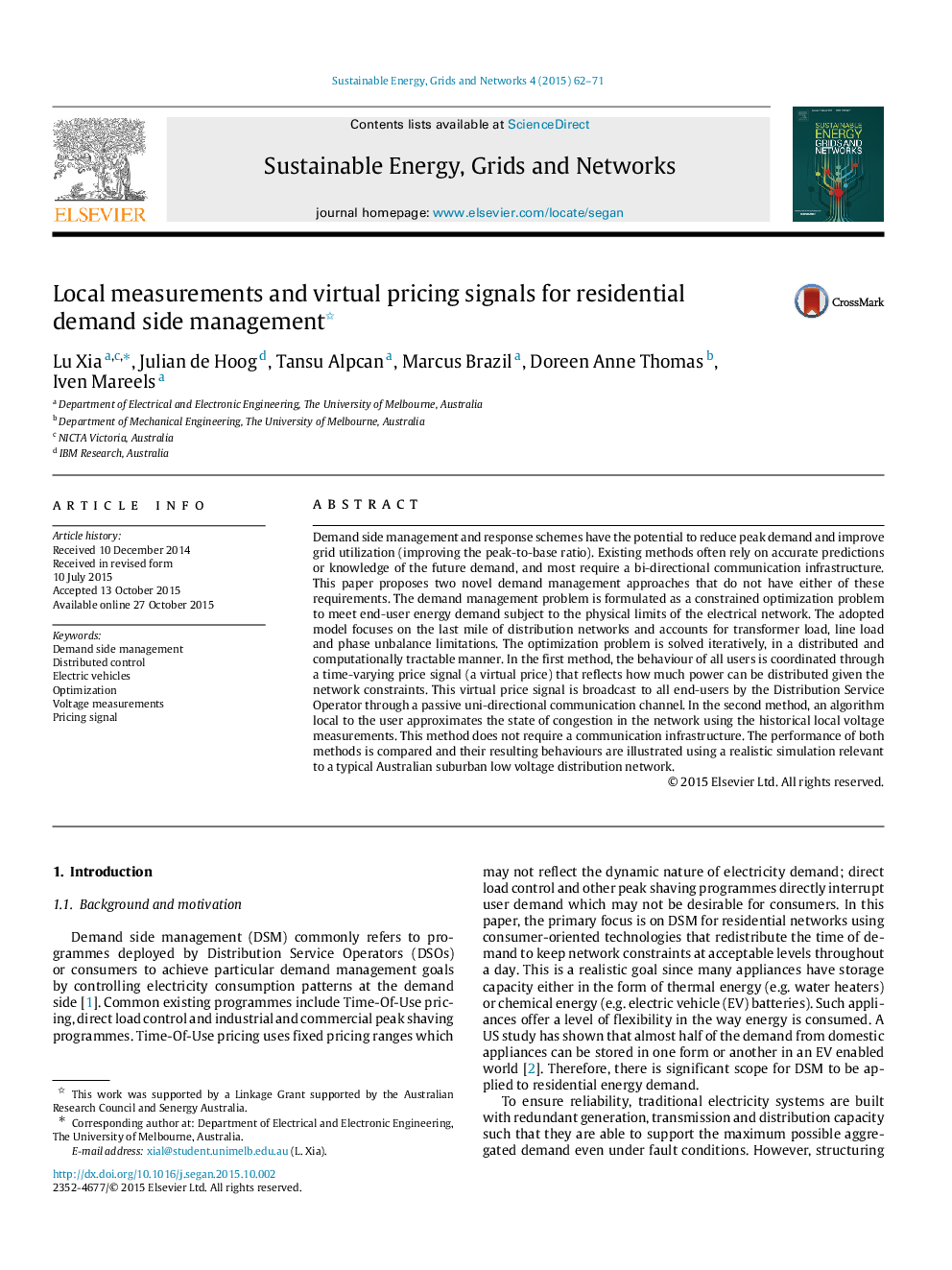| کد مقاله | کد نشریه | سال انتشار | مقاله انگلیسی | نسخه تمام متن |
|---|---|---|---|---|
| 6935609 | 868827 | 2015 | 10 صفحه PDF | دانلود رایگان |
عنوان انگلیسی مقاله ISI
Local measurements and virtual pricing signals for residential demand side management
ترجمه فارسی عنوان
اندازه گیری های محلی و سیگنال های قیمت گذاری مجازی برای مدیریت تقاضای مسکونی
دانلود مقاله + سفارش ترجمه
دانلود مقاله ISI انگلیسی
رایگان برای ایرانیان
کلمات کلیدی
مدیریت سمت تقاضا، کنترل توزیع، وسایل نقلیه الکتریکی، بهینه سازی، اندازه گیری ولتاژ، سیگنال قیمت گذاری،
ترجمه چکیده
طرح های مدیریت تقاضای و واکنش ها دارای توان بالقوه برای کاهش تقاضای پیک و بهبود استفاده از شبکه (بهبود نسبت پایه به پایه) است. روش های متداول اغلب به پیش بینی های دقیق یا دانش تقاضای آینده تکیه می کنند و اغلب نیاز به یک زیرساخت ارتباط دو جانبه دارند. این مقاله دو رویکرد جدید مدیریت تقاضا را پیشنهاد می دهد که هیچ کدام از این الزامات را ندارند. مشکل مدیریت تقاضا به عنوان یک مشکل بهینه سازی محدود شده برای پاسخگویی به تقاضای انرژی کاربر نهایی در معرض محدودیت های فیزیکی شبکه برق است. مدل تصویب شده بر روی آخرین مایل از شبکه های توزیع و حساب برای بار ترانسفورماتور، خط بار و محدودیت های عدم تعادل فاز متمرکز است. مشکل بهینه سازی به طور تکراری حل می شود، به شیوه ای توزیع شده و قابل محاسبه است. در روش اول، رفتار همه کاربران از طریق یک سیگنال قیمت متفاوت متغیر (قیمت مجازی) هماهنگ شده است که نشان دهنده چقدر قدرت را می توان با توجه به محدودیت های شبکه توزیع کرد. این سیگنال قیمت مجازی توسط اپراتور خدمات توزیع به وسیله کانال ارتباطی منفعل منفعل به تمامی کاربران نهایی منتقل می شود. در روش دوم، یک الگوریتم محلی به کاربر تقریبی وضعیت تراکم در شبکه با استفاده از اندازه گیری های ولتاژ محلی محلی است. این روش زیرساخت ارتباطی را نیاز ندارد. عملکرد هر دو روش مقایسه شده است و رفتارهای حاصل از آنها با استفاده از شبیه سازی واقع گرایانه مربوط به یک شبکه توزیع ولتاژ پایین حومه شهر استرالیا نشان داده شده است.
موضوعات مرتبط
مهندسی و علوم پایه
مهندسی کامپیوتر
نرم افزارهای علوم کامپیوتر
چکیده انگلیسی
Demand side management and response schemes have the potential to reduce peak demand and improve grid utilization (improving the peak-to-base ratio). Existing methods often rely on accurate predictions or knowledge of the future demand, and most require a bi-directional communication infrastructure. This paper proposes two novel demand management approaches that do not have either of these requirements. The demand management problem is formulated as a constrained optimization problem to meet end-user energy demand subject to the physical limits of the electrical network. The adopted model focuses on the last mile of distribution networks and accounts for transformer load, line load and phase unbalance limitations. The optimization problem is solved iteratively, in a distributed and computationally tractable manner. In the first method, the behaviour of all users is coordinated through a time-varying price signal (a virtual price) that reflects how much power can be distributed given the network constraints. This virtual price signal is broadcast to all end-users by the Distribution Service Operator through a passive uni-directional communication channel. In the second method, an algorithm local to the user approximates the state of congestion in the network using the historical local voltage measurements. This method does not require a communication infrastructure. The performance of both methods is compared and their resulting behaviours are illustrated using a realistic simulation relevant to a typical Australian suburban low voltage distribution network.
ناشر
Database: Elsevier - ScienceDirect (ساینس دایرکت)
Journal: Sustainable Energy, Grids and Networks - Volume 4, December 2015, Pages 62-71
Journal: Sustainable Energy, Grids and Networks - Volume 4, December 2015, Pages 62-71
نویسندگان
Lu Xia, Julian de Hoog, Tansu Alpcan, Marcus Brazil, Doreen Anne Thomas, Iven Mareels,
